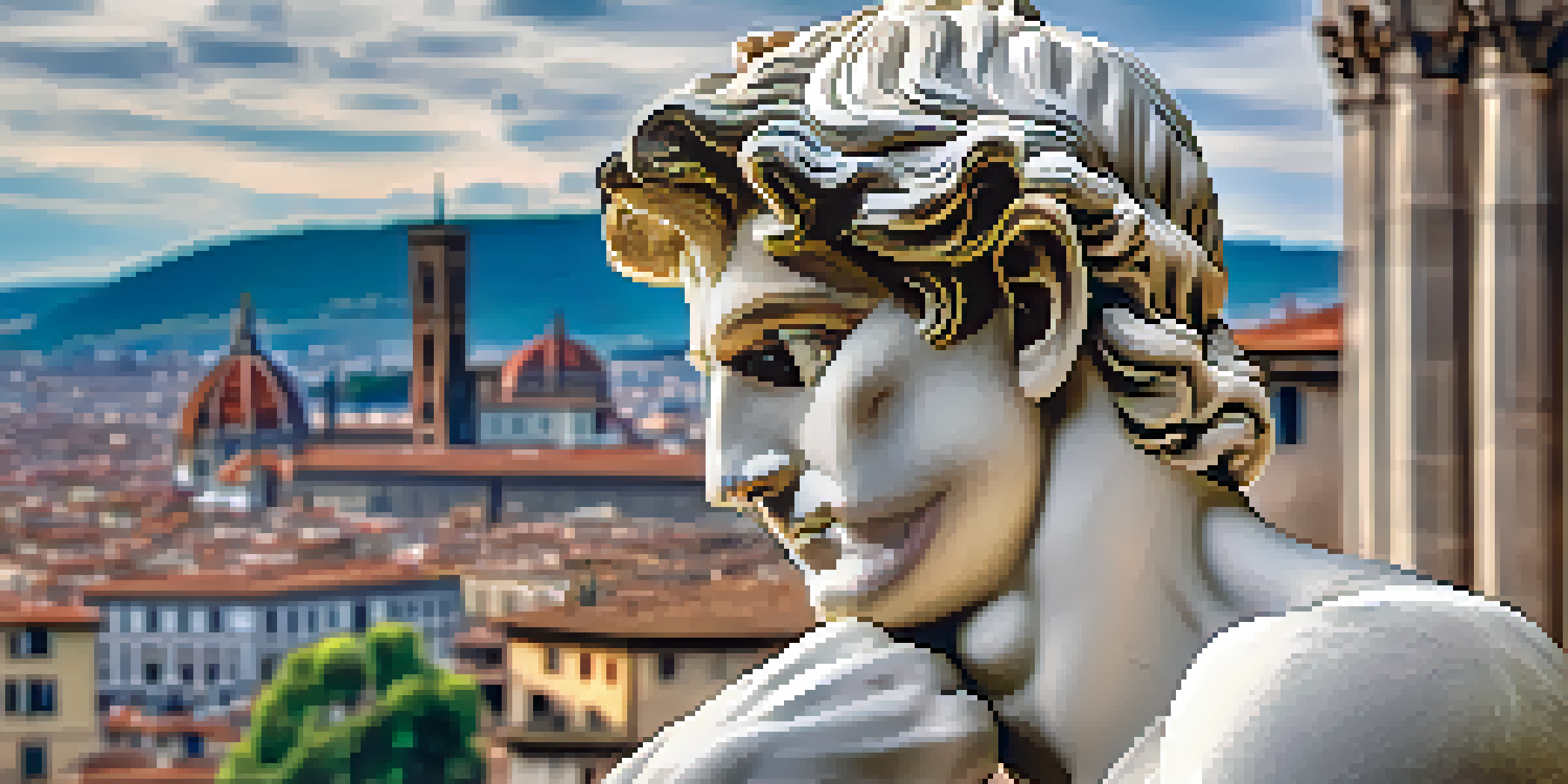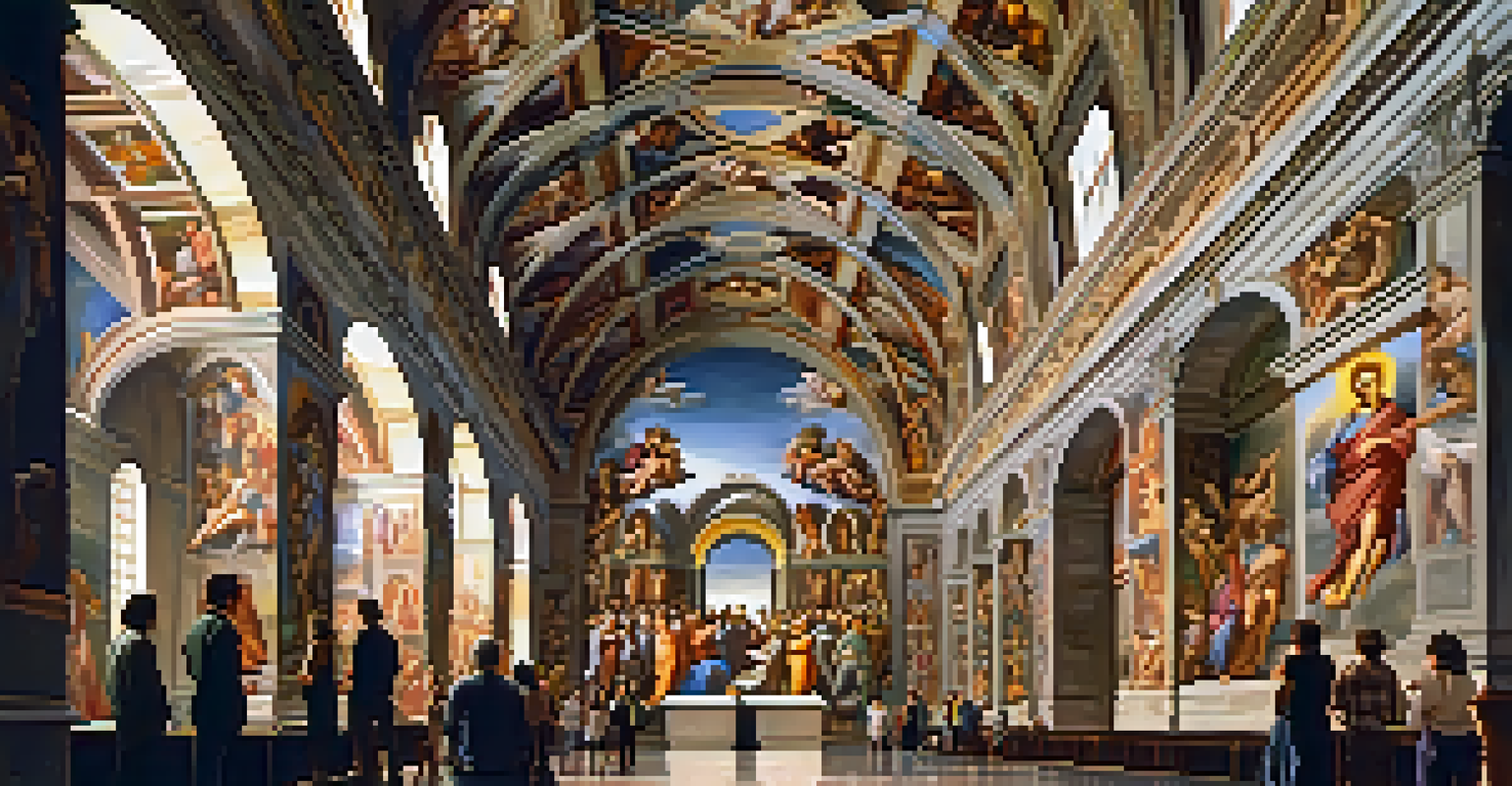Case Studies: Successful Art Restoration Projects Around the World

The Restoration of Michelangelo's David: A Daring Journey
Michelangelo's David, a symbol of Renaissance artistry, underwent a significant restoration in 2004. The project aimed to clean and restore the statue, which had accumulated grime and pollutants over centuries. Teams of experts used advanced techniques, including laser cleaning, to delicately remove harmful deposits without damaging the marble.
Art is never finished, only abandoned.
This meticulous process not only preserved the statue's intricate details but also allowed for a deeper appreciation of Michelangelo's craftsmanship. The restoration sparked renewed interest in the statue, attracting even more visitors to Florence. It serves as a reminder of the importance of maintaining cultural heritage for future generations.
In the end, the restoration of David was not just about cleaning a statue; it was a celebration of art and history. By preserving such masterpieces, we ensure that their stories continue to inspire and educate, bridging the past with the present.
Reviving the Sistine Chapel: A Testament to Care
The Sistine Chapel, famous for Michelangelo's frescoes, underwent a controversial restoration from 1980 to 1994. Many feared that the cleaning process, which involved removing layers of grime and previous restorations, could damage the original artwork. However, experts managed to bring back the vibrant colors and intricate details hidden beneath the dirt.

This restoration ignited debates about authenticity and preservation methods in art conservation. Some critics argued that the work had altered the frescoes' historical integrity, while others praised the revival of Michelangelo's vision. Regardless of opinions, the project undeniably transformed the chapel into a breathtaking experience for visitors.
Restoration Preserves Art's Legacy
Restoration projects like those of Michelangelo's David and Van Gogh's Sunflowers highlight the importance of preserving cultural heritage for future generations.
Today, the Sistine Chapel stands as a testament to the artistry of the Renaissance and the importance of careful restoration. It highlights the delicate balance between preserving the past and ensuring that art remains accessible and engaging for new audiences.
The Rescue of Van Gogh's Sunflowers: A Colorful Revival
Vincent Van Gogh's iconic 'Sunflowers' series faced a major restoration in the early 1990s. These vibrant paintings had suffered from discoloration and a buildup of varnish, obscuring their original brilliance. Conservators undertook a careful cleaning process that revealed the rich colors and textures that Van Gogh intended.
To preserve the past is to secure the future.
The restoration not only revived the visual impact of the paintings but also reignited interest in Van Gogh's work. It showcased the artist's unique technique and emotional depth, encouraging a new generation to appreciate his contributions to art. The careful restoration process became a case study in balancing preservation with the need for visibility.
Ultimately, the restoration of 'Sunflowers' exemplifies how art can transcend time, continuing to resonate with audiences. By reviving these masterpieces, we celebrate Van Gogh's legacy and remind ourselves of the powerful emotions art can evoke.
The Parthenon Marbles: A Complex Restoration Story
The Parthenon Marbles, housed in the British Museum, have been a subject of controversy and restoration efforts for decades. These ancient sculptures, originally from the Parthenon in Athens, underwent various cleaning and restoration projects that often sparked debate over ethics and ownership. Each restoration aimed to preserve the marbles while navigating the complex history surrounding them.
One significant restoration in the 1930s involved cleaning the sculptures with harsh chemicals, leading to further damage. However, more recent approaches have focused on using gentler methods to stabilize and preserve the remaining fragments. This ongoing journey highlights the challenges conservators face, balancing restoration with respect for historical context.
Community Drives Art Restoration
Community involvement in art restoration projects fosters local pride and ensures that the stories behind artworks are honored and shared.
The story of the Parthenon Marbles serves as a reminder of the intricate relationship between art, history, and cultural heritage. It emphasizes the need for thoughtful dialogue about preservation and the importance of returning art to its rightful home whenever possible.
The Restoration of Leonardo da Vinci's The Last Supper
Leonardo da Vinci's 'The Last Supper' has faced numerous restoration challenges since its completion in the late 15th century. The painting, located in Milan, Italy, suffered from environmental damage, poor restoration attempts, and even bomb damage during World War II. Each intervention sought to preserve this iconic masterpiece while maintaining its integrity.
The most notable restoration took place between 1978 and 1999, employing modern techniques to remove layers of grime and previous restoration efforts. The painstaking process revealed the original colors and details that had been lost over time. This project highlighted the delicate balance between restoration and preservation, emphasizing the need to respect the artist's original vision.
Today, 'The Last Supper' stands as a testament to both da Vinci's genius and the dedication of conservators. It reminds us of the importance of preserving cultural treasures for both current and future generations, ensuring that these artistic legacies continue to inspire.
Restoring the Ancient Mosaics of Pompeii
The ancient city of Pompeii, buried under volcanic ash, is home to stunning mosaics that have been the focus of restoration efforts. These intricate artworks provide a glimpse into Roman life and artistry, but many were damaged due to exposure and neglect. Conservation projects have aimed to stabilize and restore these mosaics, preserving their historical significance.
One significant project involved the restoration of the 'Cave Canem' mosaic, which depicts a fierce dog. Conservators meticulously cleaned and repaired the mosaic using both traditional techniques and modern materials. This careful approach ensured that the mosaic retained its authenticity while remaining visually accessible.
Balancing Preservation and Authenticity
The restoration of significant artworks, such as the Sistine Chapel and The Last Supper, underscores the delicate balance between maintaining authenticity and enhancing visibility.
The restoration of Pompeii's mosaics not only highlights the artistry of ancient Rome but also serves as a reminder of the challenges faced in preserving archaeological sites. By safeguarding these treasures, we keep the stories of the past alive, enriching our understanding of history.
Reviving the Iconic Works of the Dutch Masters
The Dutch Masters, including artists like Rembrandt and Vermeer, have inspired art lovers for centuries. However, their works often require restoration due to age and environmental factors. Recent restoration projects have focused on uncovering the original techniques and vibrant colors that these artists employed, providing a clearer understanding of their artistry.
For instance, Rembrandt's 'The Night Watch' underwent a significant restoration that revealed lost details and enhanced the painting's dramatic impact. This meticulous process involved removing layers of varnish and previous restorations, allowing the artwork to shine in its full glory. The project not only revived the painting but also sparked renewed interest in Rembrandt's techniques.

By restoring the works of the Dutch Masters, conservators help us connect with the past and appreciate the skill involved in these timeless pieces. These projects remind us that art is a living entity, deserving of care and attention to ensure its legacy continues.
The Importance of Community in Art Restoration Projects
Art restoration is not just a task for experts; it often involves the community's support and involvement. Numerous successful projects have relied on local volunteers and organizations to help restore public artworks, fostering a sense of ownership and pride. This collaboration enhances the restoration process and builds stronger community ties.
One example is the restoration of murals in neighborhoods that have faced neglect. Local artists and residents come together to revitalize these spaces, transforming them into vibrant expressions of culture and history. This grassroots approach not only beautifies the community but also educates participants about the importance of preservation.
Ultimately, community involvement in art restoration emphasizes the idea that art belongs to everyone. By engaging local voices and talents, these projects create a shared sense of purpose, ensuring that the stories behind the artworks are honored and passed down through generations.